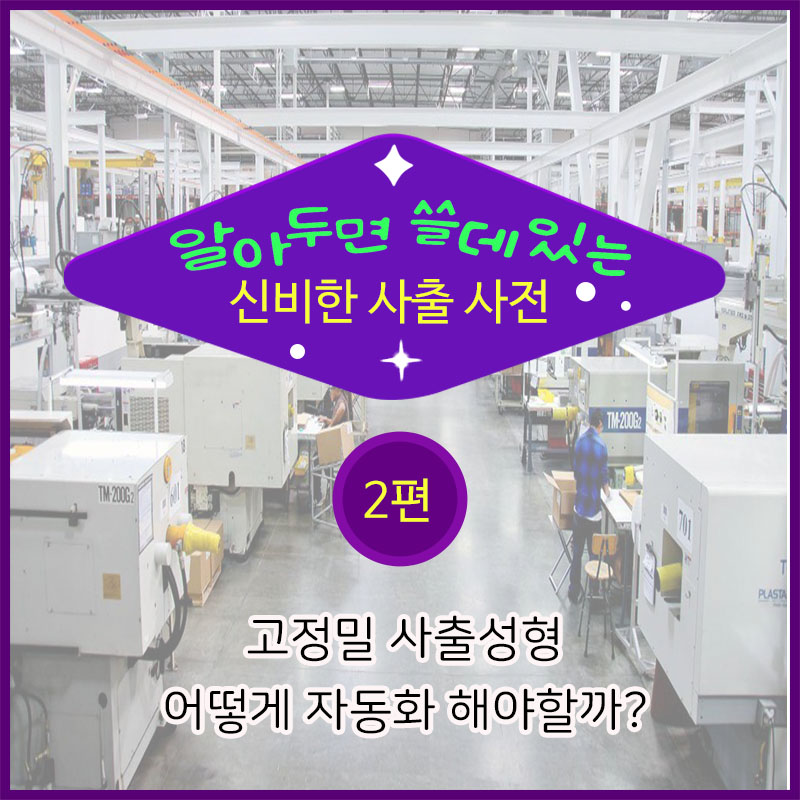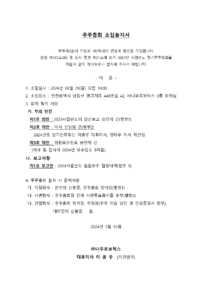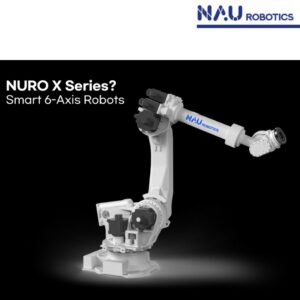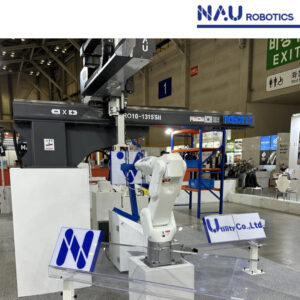
안녕하세요. 나우로보틱스의 블로그 지기 나우지기 입니다. 사출성형과 관련해서 나우로보틱스가 항상 다양한 소식들을 전해드리고 있습니다! 나우로보틱스가 직접 진행했던 사출성형 현장에서 산업용 로봇을 도입해 성공시킨 사례부터 사출성형을 전문으로 다루는 외신 매체 속에서 다루고 있는 다양한 이야기들을 직접 전달해 드리고 있는데요,
오늘은 고정밀 사출성형과 관련한 이야기들을 해볼까 합니다! 사출성형도 날이 가면 갈수록 굉장히 디테일하고 기존 시장에 나와있는 산업용 로봇으로는 사출을 진행하기 어려운 경우들도 많이 생겨나고 있는데요, 그만큼 사출성형을 자동화 하는 것이 날이 갈수록 까다로워지고 어려워지고 있다고 볼 수 있습니다. 또한 정밀도 역시 높아지고 있는만큼 사출성형을 진행하는데 더욱 어려움이 많아질 텐데요,
이렇게 시간이 흐를수록 점점 어려워지는 사출성형, 그 중에서도 고정밀 사출성형을 어떻게 하면 자동화를 할 수 있을지에 대해 오늘 이 시간에 알아보도록 하겠습니다! 그럼 지금부터 함께 보실까요~?
How to Automate High-Precision 'Micro' Insert Molding?
고정밀 사출성형은 어떻게 자동화 할 수 있을까?
(E) Insert overmolding is an exacting technique in injection molding, but in its early days, it was not often handled by a robot—it usually required the assistance of human hands, especially for inserts with more difficult geometry. The robot technology and know-how of those days was not yet very capable for insert handling. Loading inserts into the tool was done—and sometimes still is—manually by workcell operators, especially for inserts that presented challenges in size, shape or the need for precise location and orientation.
(K) 인서트 오버몰딩은 사출성형 분야에 있어 고도의 기술이지만 초기에는 로봇을 도입하지 못했다. 사람의 수작업(손)이 필요로 했기 때문이다. 또한 당시 로봇 기술과 노하우로는 인서트 몰딩을 다루기 쉽지 않았다. 공구에 인서트물을 삽입하는 작업은 때때로 작업 셀을 다루는 작업자가 수작업으로 진행을 했으며, 오늘날까지도 이어져 오고 있다.
(E) For years, horizontal machine operators would wait for the mold to fully open, let the parts fall, slide open the safety gate, carefully orient and hand-load the inserts into the mold, close the gate, and continue the overmolding cycle. It was an inefficient and labor-intensive method; the opening and closing of gates lengthened cycle times; and it was often prone to inaccurate insert orientation. Vertical molding machines had similar challenges, but this article focuses on horizontal-clamp machines, which are much more common among molding shops and are favored for higher production insert molding. And because top-entry robot design favors horizontal machines, vertical presses did not experience the benefit of technological advances in this type of automation.
(K) 수년동안에는 수평사출기를 다루는 작업자가 몰드가 완전히 열리기까지 기다린 후 부품을 제거하고 안전게이트를 열어 조심스럽게 방향을 잡아 몰드에 삽입물을 손으로 이동시킨 후 다시 안전 게이트를 닫고 오버몰딩 공정을 이어가는 방법으로 진행했다. 이 방식은 비효율적이면서 매우 노동집약적인 방식으로 특히 게이트 개폐가 작업시간을 길게 만들었으며 종종 인서트 방향이 부정확하단 문제도 있었다. 수직사출기도 비슷한 문제가 있었지만 이 기사에서는 수평사출기 위주로 다뤘다. 수평 클램프 기계는 성형 공장들 사이에서 훨씬 더 흔하고 더 높은 사출성형의 생산력을 높이는 것에 초점을 맞춘다. 또한 유명 로봇 디자인들이 수직사출기를 선호하며, 수평사출기에는 자동화로 인한 기술적인 발전을 아직 적용하지 못했다는 문제가 있다.
(E) Time is technology’s friend, and robot technology has much improved, particularly for horizontal injection molding and top-entry linear robots. Nowadays, most molders with higher production runs for overmolded insert parts have automated the process with top-entry linear robots to streamline the process, save direct-labor cost, and improve quality control.
(K) 시간이 흐르면서 기술도 발전을 거듭해 로봇 기술은 진보했으며 특히 수평 사출과 선형 로봇 발전이 두드러졌다. 오늘날 오버몰드 인서트 부품의 생산을 주로 하고 있는 금형 제작자들은 공정을 간소화하고, 인건비를 절약하며, 품질 개선을 위해 탑 엔트리 성형 로봇을 이용해 공장 자동화를 실현했다.
(E) But what works for common overmolding applications with “normal” sized inserts and parts, is not necessarily sufficient for the micro-sized inserts and parts that are increasingly common in this era of miniaturization in electronics, medical devices and micro-mechanical systems. A dozen of these inserts might fit on a penny. This scale offers a much greater challenge to molders and robot suppliers alike.
(K) 하지만 정상적인 크기의 인서트물과 부품을 일반적인 오버몰딩에 적용하는 것은 전자, 의료기기 및 마이크로 기계 시스템이 소형화 되고 있는 시대를 맞아 점점 더 보편화 되고 있는 초소형 크기의 부품에 충분하지 않다. 이것은 금형 제작자와 로봇 공급업체 모두에게 큰 도전이다..
Micro Size, Big Challenges
작은 사이즈, 큰 도전

(E) At the micro scale—say, less than 3 mm—insert overmolding is still often done manually (or not at all) because of the challenges of automated handling such tiny inserts. This means the part design often defaults to a two-piece assembly rather than an integrated one-piece overmolding. Why? Because molders and part designers aren’t always aware of the capability of the latest generation of injection molding robots or the capability of the suppliers’ custom automation engineering groups to manage and successfully implement such workcells.
(K) 초소형 사이즈(3mm미만)의 인서트 오버몰딩은 작은 인서트물을 자동으로 처리해야 하는 문제로 여전히 수작업으로 진행하고 있다. 즉 부품 설계가 분리된 형태가 아닌 하나로 되는 경우가 많다. 왜 그럴까? 몰더와 부품 설계자가 최신 사출 성형 로봇의 기능이나 공급업체의 맞춤형 자동화 엔지니어링 그룹이 작업 셀을 관리하고 구현해내는 것을 항상 알고 있지는 못했기 때문이다.
(E) Micro applications may not be suited to your existing older-generation robot that still “goes through the motions.” But today’s top-entry linear robots feature such advances as higher precision (<1 mm) drive trains, multi-axis precision servo motors, and software control. When seen from a distance on a shop floor, today’s higher-tech top-entry linear robots don’t appear much different from earlier models of 20 years ago. But they are, in fact, more accurate, more programmable, more capable, and easily integrated with custom automation. Just as important, some robot suppliers’ custom automation engineering capabilities have grown to match the more advanced-generation robots they supply.
(K) 마이크로 애플리케이션은 모션을 수행하는 기존 구형 로봇에는 적합하지 않을 수 있다. 그러나 최근 톱 엔트리 선형 로봇에는 정밀도가 높은(1mm 미만)의 드라이브 트레인, 다축 정밀 서보 모터, 소프트웨어 제어 기능 등이 구축돼 있다. 본체와 멀리 떨어져서 보면 첨단 톱 엔트리 선형 로봇은 20년전의 모델과 크게 달라 보이지 않는다. 그러나 실제로는 자동화 프로세스에 맞춰 훨씬 더 정확하고 프로그래밍이 용이하다. 또한 중요한 것은 로봇 공급업체의 맞춤형 자동화 엔지니어링 능력이 고급 로봇에 버금갈 정도로 성장했다.
(E) And critically, in terms of project management, the molder can have confidence in a qualified primary robot supplier to take responsibility for the complete robot and automation workcell, so the molder does not have to go to a separate third-party integrator for special insert-molding applications. Managing a project with one supplier has to be better than managing two, right?
(K) 프로젝트 관리 측면에서, 작업자는 로봇과 자동화 셀 영역을 맡기 위해 로봇 공급업체와의 신뢰를 중요하게 여긴다. 따라서 작업자는 특수 인서트 몰딩을 적용하기 위해 별도의 타사 통합업체를 찾을 필요가 없다. 한 공급업체로 프로젝트를 관리하는 것이 두 곳으로 하는 것보다 당연히 더 편하지 않나
Real-World Examples
광범위한 사례

(E) High-precision micro-insert molding is now being successfully implemented on precision horizontal injection molding machines in the 15-ton to 165-ton range with molds “smartly” designed to facilitate automation from the outset for such applications before mold steel is cut. Here are two illustrative examples of micro-insert applications and the accompanying challenges:
(K) 고정밀 마이크로 사출성형은 금속몰드를 절단하기 전 자동화가 용이하도록 설계된 15톤에서 165톤 가량의 정밀 사출기계를 통해 성공적으로 구현되고 있다. 다음은 마이크로 인서트 적용 예시와 두 가지 과제다.
(E) Example Project A is a polyetherimide (Ultem) electrical part less than 1 in. long, with a cylindrical, ceramic polymer insert measuring 1.25 mm (0.0492 in.) diam. The mold has eight cavities, and the locational tolerance of insert placement in each cavity is 0.01 mm (0.0005 in.) The inserts must be oriented front to back.
(K) 예시. 프로젝트A는 1인치 미만의 폴리에티크화물 전기 부품이며, 직경 1.25mm의 원통형 세라믹 폴리머 인서트물이다. 금형에는 8개의 공동이 있으며 공동의 삽입 위치 공차는 0.01mm다. 인서트물은 전면에서 후면 방향으로 배치해야 한다.
(E) The cell includes a 110-ton press, a top-entry linear robot, and vision inspection to confirm that the insert is present and orientation of the substrate in the overmolded part. The robot places the parts on an exit conveyor that indexes by shot.
(K) 셀에는 110톤 프레스, 탑 엔트리 선형 로봇과 비전검사가 포함돼 있어 인서트물 여부를 확인하고 오버몰딩된 부품에 기질의 방향을 확인한다. 로봇은 부품을 샷으로 인덱싱 하는 출구 컨베이어 위에 놓는다.

(E) The challenges for this project included:
(K) 과제는 다음과 같다.
(E) Ensuring the quality of the inserts—i.e., that they are consistently within tolerance and are very free of contamination such as dust, dirt, specs, static or moisture.
(K) 인서트물의 품질 보장 – 품질이 일정하게 유지되면서 먼지, 정전기, 습기와 같은 오염 물질이 없어야 한다.
(E) Ensuring that the insert is kept at the correct orientation as it moves from the automated bulk feeding station prior to the overmold process, prior to mold insertion and are correctly seated in the mold cavity before the mold closes. Robot-integrated cameras and vision sensors handled this requirement.
(K) 오버몰딩 전과 금형에 삽입 하기 전에 자동 벌크 공급 스테이션에서 이동할때 인서트물이 올바른 방향으로 유지되고 금형이 닫히기 전에 구멍에 올바르게 안착됐는지 확인한다. 로봇 통합 카메라와 비전센서가 이것을 처리했다.
(E) Careful calculations of mold-steel thermal expansion, which could affect the tolerance of the cavities and seating of the micro-inserts and thus quality of the overmolded part. This is especially critical when processing at such tiny scales and high tolerances.
(K) 마이크로 인서트의 공차, 착석 공차, 오버 몰딩 부품이 품질에 미칠수 있는 요인 중 금속몰드 열팽창을 정확히 계산하는 것. 이것은 작은 규모와 높은 공차를 처리할 때 특히 중요하다.
(E) Common insert application issues, such as the mold location on the platen had to be perfectly level, square and plumb. This is also required for the mating robot EOAT, even if the latter has mold-engagement alignment pins.
(K) 판 위의 금형 위치와 같은 일반적인 인서트 적용 문제는 수평, 사각, 수직이어야 한다. 몰드 정렬핀이 있더라도 이 작업은 로봇 지그에 필요하다.
(E) Example Project: B is another electrical part, this one of PBT with a cylindrical metal insert. The insert size is less than 2 mm and it must be inserted into 4 cavities with front-to-back orientation and location tolerance of 0.03 mm (0.0012 in.). Vision sensors check insert orientation and presence in the mold. Cycle time is 15 sec in a 110-ton press.
(K) 예시 프로젝트: B는 또다른 전기 부품이며 이 부품은 원통형 금속 인서트를 이용하는 PBT다. 삽입 크기는 2mm 미만이며 앞뒤 방향과 위치 공차가 0.03mm인 4개 구멍에 삽입해야 한다. 비전 센서는 몰드의 삽입 방향 및 존재 여부를 확인한다. 110톤 프레스에서 사이클 시간은 15초다.
(E) The challenges for this metal micro-insert overmolding project were very similar to those of Project A. One difference is that metal rather than ceramic inserts must be free of oxidation and coatings to avoid introducing contaminants. On the other hand, ceramic inserts may be more abrasive, and thus special consideration must be made for use of hardened contact surfaces. Also, metal inserts tend to be less fragile and heavier than ceramic inserts, so gripping and handling metal inserts might be a tad easier, though there is nothing easy about handling objects the size of a grain of rice.
(K) 이 금속 마이크로 인서트 오버몰딩 프로젝트의 과제는 프로젝트 A의 과제와 매우 유사하다. 한 가지 차이점은 세라믹 인서트물이 아닌 금속이며 산화와 코팅이 없어야만 오염 물질이 침투하지 않는다는 것이다. 반면 세라믹 인서트는 연마성이 더욱 강할 수 있어 접촉면의 사용을 특별히 고려해야 한다. 또한 매우 작은 물체를 다루는 다루는 것이 쉽진 않지만, 금속 인서트는 세라믹 인서트 보다 더 강하고 무겁기 때문에 잡고 조작하는 면에서는 오히려 더 쉬울 것이다.
Lots of Factors to Control많은 통제 요소

(E) Other common technical considerations for automated handling of micro-inserts and parts include:
(K) 마이크로 인서트물 및 부품의 자동 핸들링을 위한 다른 기술적 고려사항은 다음과 같다.
(E) Static charge: Even the tiniest static charges can affect the insert and part, and so tests must be made to determine if the parts or inserts have to be de-static washed or bathed in clean de-ionized air.
(K) 정전하: 아무리 작은 정전기라도 인서트물과 부품에 영향을 줄 수 있으므로 정전기를 제거 또는 깨끗한 공기로 세척해야 하는지 여부를 결정하기 위해 테스트를 수행해야 한다.
(E) Environmental control: Parts and inserts of this tiny scale are more consistently handled if managed in environments with controlled temperature, humidity and air flow. Ambient temperature changes might change the size of the insert, which is critical at precise tolerances. Humidity might negatively affect any hygroscopic polymers; and air flow (such as draft from a nearby vent or doorway) might push the tiny insert or part out of position. Well-designed enclosures and HEPA filters are often used to alleviate these risks, as well as controlling particulate contaminants.
(K) 환경 조건: 온도, 습도, 공기흐름이 통제된 환경에서 관리하면 작은 규모의 부품과 인서트물을 보다 일정한 수준으로 취급할 수 있다. 주변 온도 변화로 인해 인서트물의 크기가 변경될 수 있으며, 이는 정확한 공차에서 매우 중요하다. 습도는 습도 고분자에 부정적인 영향을 줄 수 있고 미세한 흐름(근처 환기구나 출입구 부근 외풍)이 부품을 제 위치에서 밀어낼 수도 있다. 잘 설계된 인클로저와 HEPA 필더는 이런 위험을 완화시켜주고 미립자와 오염물을 통제하는데 종종 사용된다.
(E) Micro-insert consistency and quality control: Inserts must be very consistent and highly QC’d for dimensions, flash, debris, and other specs by the supplier for consistent inserting and handling.
(K) 마이크로 인서트 품질의 일관성과 관리: 인서트물은 일관된 삽입과 취급 과정을 위해 공급업체가 치수, 플래시, 이물질, 기타 요소 등을 엄격한 qc과정을 거쳐 확인해야만 한다.
(E) Micro-parts detection: The need for workcell vision cameras vs. simple vision sensors will be determined through testing. In all likelihood, more advanced vision technology will be needed for tasks such as orientation, inspection, mold-seating confirmation, and post-mold QC. The naked eye is usually not up to such small-scale inspections.
(K) 마이크로 부품 감지: 작업 셀의 비전 카메라와 비전 센서에 대한 필요 여부는 테스트를 통해 결정된다. 모든 경우에 방향, 검사, 금형안착, 확인, 몰드 후 QC와 같은 작업에 고급 비전 기술이 필요하다. 육안검사는 규모가 작은 검사에서는 적합하지 않다.

(E) Micro-EOAT gripper precision: The robot and automation grippers and fingers will be machined to very high tolerances and often made of special materials based on the application need.
(K) 마이크로 EOAT 그리퍼 정밀도: 로봇, 자동화 그립과 손가락은 매우 높은 공차로 가공되며 어플리케이션 용도에 따라 특수 재료도 제작된다.
(E) Insert feeding: This will not be your plain-vanilla, garden-variety bowl feeder; careful consideration will be made to the feeder design and materials of construction, tight tolerances, and creative orientation management with precision sensors confirming each step of the process.
(K) 인서트 피딩: 이것은 플레이 바닐라, 가든 버라이어티 볼 피더가 아니며, 공정의 각 단계를 확인하는 정밀 센서를 통해 피더 디자인과 재료, 공차, 방향 관리 등을 신중하게 고려해야 한다.
(E) Mold seating and engagement: To assist in making the initial setup easy, the robot EOAT often will include a docking feature to dock with the mold while locating the micro-inserts. This also ensures consistent inserting and demolding. The EOAT might not include common mechanical grippers, because the inserts are so small; rather, pneumatic tubes on the EOAT might be used to seat the micro-inserts into the mold cavities.
(K) 금형 시트와 체결: 초기 설정을 쉽게 하려면, 로봇지그에는 마이크로 인서트물을 찾는동안 금형에 대는 도킹 기능이 포함돼 있는 경우가 많다. 또한 지속적인 인서트와 몰딩해제도 한다. 로봇지그는 일반적인 기계식 그립은 포함되지 않는데 인서트물이 너무 작기 때문이다. 오히려 로봇지그의 공압 튜브를 사용해 마이크로 인서트물을 금형의 구멍에 장착할 수 있다.
(E) A plethora of other fine details to consider for optimized inserting, demolding and handling of micro-inserts and micro-parts will be familiar to an experienced robot supplier during the specifications and design-review phase of the project.
(K) 마이크로 인서트 및 부품에 알맞은 삽입과 몰딩 작업들을 위해 고려해야 다양한 기타 사항은 로봇 공급업체가 프로젝트의 사양 및 검토단계에서 파악할 수 있다.
(원문출처: 플라스틱 테크놀로지)
이렇게 기사를 통해서 고정밀 사출성형을 하는데 있어 중요한 요소들과 어떻게 하면 자동화 시스템을 구축할 수 있을지에 대해 알아보았습니다! 역시 일반 사출성형보다 더욱 까다로운만큼 통제요소도 그만큼 많다는 것을 알 수 있습니다! 산업용 로봇을 통해 자동화 시스템울 구축하고 싶으신 분들께서 참고하시면 많은 도움이 되리라 생각됩니다!








